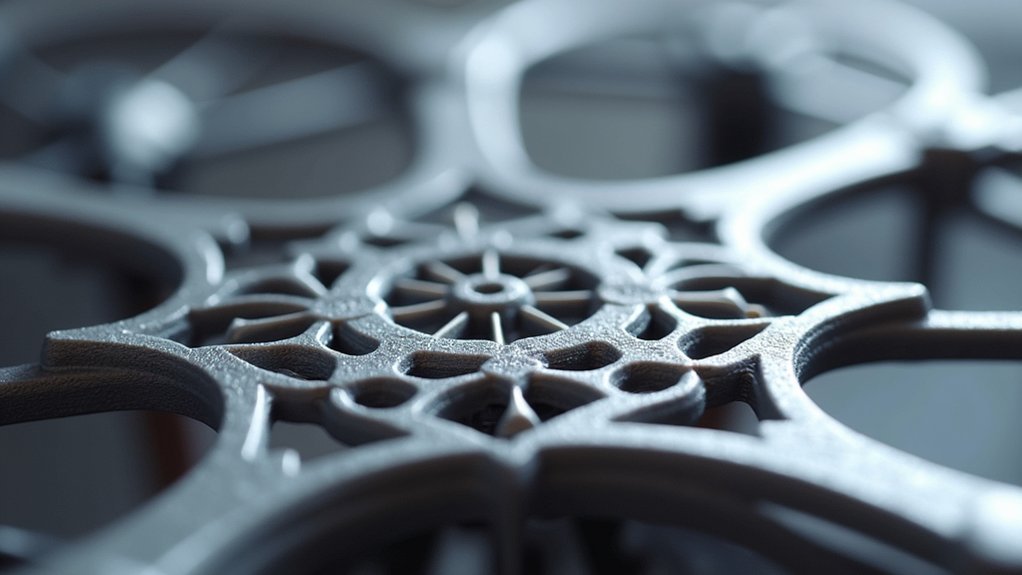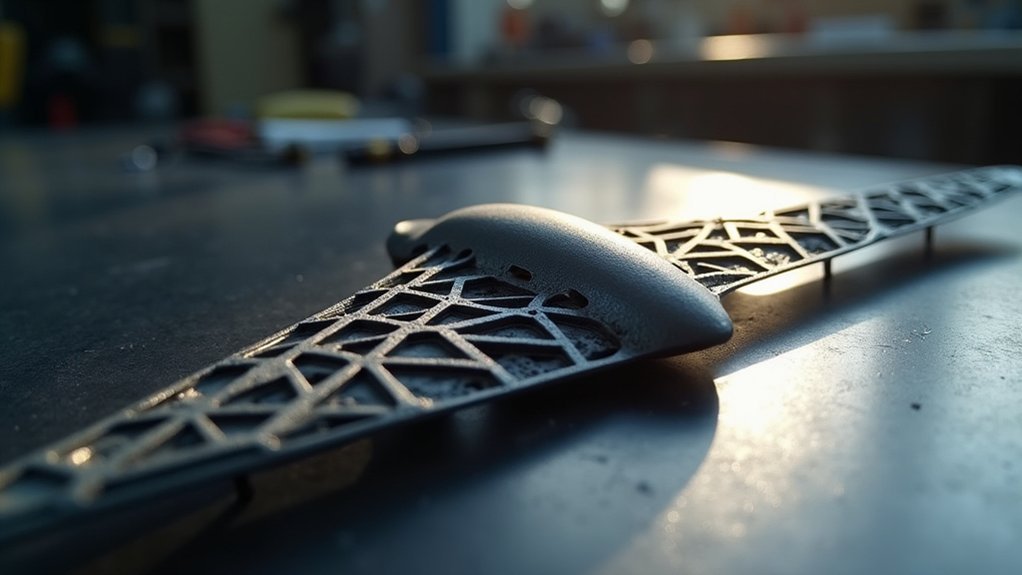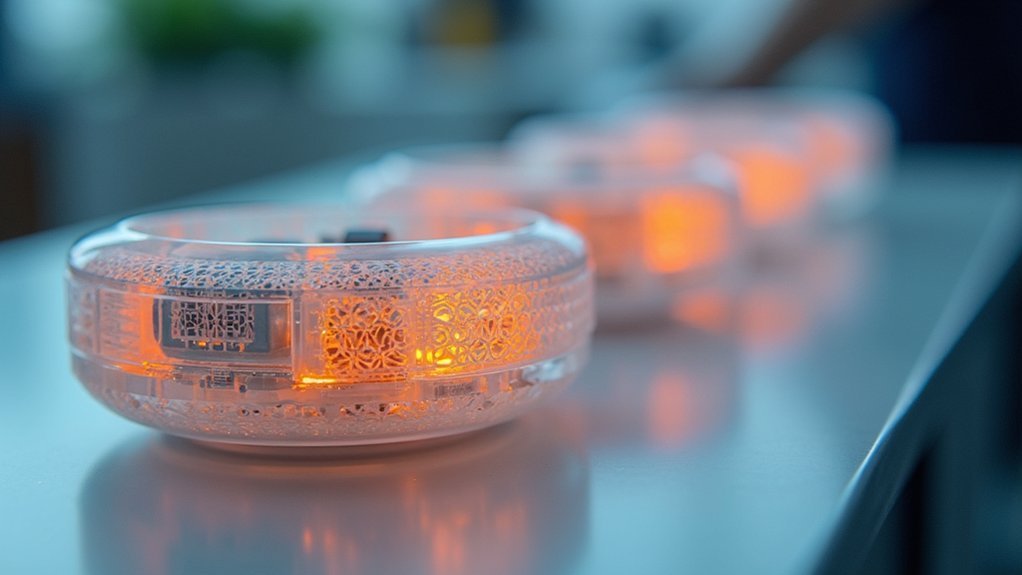You’ll achieve peak drone performance by implementing gyroid infill at 10-20% density for non-structural components, which provides exceptional strength-to-weight ratios through its continuous 3D wave structure. For critical parts, use honeycomb infill at 30-50% density to maximize structural efficiency, while lightning infill works perfectly for ultra-lightweight covers and mounts. Configure cubic subdivision settings for adaptive density control, triangular infill for multi-directional strength, and refine layer height to 0.25mm with 10% infill overlap. These strategic configurations release advanced enhancement techniques that’ll revolutionize your builds.
Gyroid Infill Pattern for Optimal Strength-to-Weight Ratio

When designing lightweight drone components, you’ll find that Gyroid infill delivers an exceptional strength-to-weight ratio that’s hard to match with traditional patterns.
This continuous 3D wave structure distributes loads multidirectionally, ensuring your drone parts handle stress from various angles effectively.
For non-structural components, you’ll achieve ideal strength with just 10-20% infill density while maintaining excellent durability and impact resistance.
The pattern’s relatively fast printing speed reduces material usage and print time compared to complex alternatives.
Gyroid’s streamlined geometry prints faster than intricate patterns, cutting both material waste and production time for efficient drone manufacturing.
When you need maximum performance, consider increasing density to 40% – testing shows these lightweight prints can support approximately 68 kg before failure.
The Gyroid’s efficient geometry makes it your go-to choice for drone applications requiring both structural integrity and minimal weight penalties.
Cubic Subdivision Settings for Adaptive Density Control
You’ll find that Cubic Subdivision’s algorithm complexity actually works in your favor by automatically adjusting density where your drone needs it most.
This smart approach cuts your material usage by 15-30% compared to uniform infill patterns while maintaining structural integrity in critical load-bearing areas.
The pattern preserves strength through its adaptive grid system that concentrates material along stress paths and reduces it in less critical zones.
Algorithm Complexity Benefits
Although traditional infill patterns offer straightforward geometric approaches, Cubic Subdivision’s algorithm complexity delivers significant performance advantages for drone manufacturing.
You’ll benefit from sophisticated mathematical calculations that dynamically adjust infill pattern and density throughout your lightweight drone parts, optimizing print efficiency while maintaining structural requirements.
The algorithm’s advanced processing creates distinct advantages:
- Adaptive mesh refinement – You’ll see varying cell sizes that concentrate material where stress analysis indicates maximum load requirements.
- Hierarchical subdivision – Your parts receive graduated density shifts from solid perimeters to hollow cores.
- Load-path optimization – Material selection follows predicted force vectors through critical structural zones.
- Memory-efficient processing – Complex geometries calculate without overwhelming your slicer’s computational resources.
This sophisticated approach transforms basic Cubic Subdivision into an intelligent material distribution system for superior drone component performance.
Material Usage Reduction
Since Cubic Subdivision’s intelligent algorithm adapts material placement based on structural requirements, you can achieve dramatic filament savings while maintaining the strength your drone components demand.
This advanced infill pattern strategically reduces material usage by creating interconnected cube designs that distribute loads efficiently across your lightweight drone components.
You’ll want to configure your infill density between 10-20% for non-structural parts, optimizing the balance between weight and durability.
When you implement adaptive density settings in UltiMaker Cura, you’re enabling the software to automatically adjust material placement where it’s needed most.
This targeted approach can deliver material usage reduction exceeding 30% compared to traditional patterns, making your drone builds more cost-effective without sacrificing performance during flight operations.
Strength Preservation Methods
When implementing Cubic Subdivision for drone parts, you’re leveraging adaptive density control that automatically strengthens critical stress points while maintaining minimal weight throughout your components.
This intelligent approach adjusts infill density based on geometry requirements, ensuring structural integrity where it matters most while keeping non-critical areas lightweight.
Your Cubic Subdivision settings should target these key areas:
- Motor mounts – Increase density to 15-20% for vibration resistance and secure attachment points.
- Landing gear connections – Boost infill density to handle impact forces during touchdown.
- Battery compartments – Maintain 10-15% density for adequate protection without excess weight.
- Wing joints – Apply higher density zones where wings connect to the fuselage frame.
This strategy reduces print times while delivering lightweight designs that withstand dynamic flight forces effectively.
Honeycomb Infill Configuration for Maximum Structural Efficiency
While choosing the right infill pattern for your drone components, honeycomb stands out as the gold standard for achieving maximum structural efficiency.
You’ll benefit from its exceptional strength-to-weight ratio, which maximizes structural integrity while keeping your drone lightweight. The hexagonal geometry distributes loads effectively, delivering superior rigidity and impact resistance compared to simpler patterns.
Set your infill density between 30-50% for ideal performance. This range provides sufficient strength without adding unnecessary weight to critical components like frames and landing gear.
However, you’ll need to account for increased print time due to honeycomb’s complex structure. Fine-tune your print settings carefully to balance speed with performance.
This configuration greatly enhances durability, especially for components experiencing frequent mechanical stress during flight operations.
10-20% Density Guidelines for Non-Critical Components

When you’re designing non-critical drone components, you’ll find that 20% infill density hits the sweet spot between structural integrity and weight reduction.
You can optimize your pattern selection by choosing simple infill types like Grid or Lines, which minimize print time while delivering adequate strength for parts that won’t bear significant loads.
This density level guarantees you’ll maintain the essential weight-performance balance that keeps your drone agile without sacrificing the durability needed for covers, housings, and aesthetic components.
Optimal Pattern Selection
Three proven infill patterns deliver ideal results at 20% infill density for non-critical drone components.
Your best pattern selection should prioritize strength-to-weight ratios while maintaining efficient printing. These infill settings create a good balance between structural integrity and material conservation for lightweight drones.
Consider these top-performing patterns for your drone parts:
- Gyroid infill – Features continuous 3D wave structures that distribute stress evenly throughout the component, creating superior durability without excess weight.
- Cubic infill – Provides multidirectional load-bearing capacity with straightforward geometric patterns that print reliably and consistently.
- Honeycomb infill – Delivers exceptional strength-to-weight performance through hexagonal cell structures, though requiring extended print times.
- Grid infill – Offers simple, fast printing with adequate strength for basic covers and non-structural mounts.
Weight Performance Balance
Since weight directly impacts flight performance and battery life, achieving the right balance between structural integrity and minimal mass becomes essential for your drone’s non-critical components.
You’ll find that 20% infill density strikes an ideal compromise for camera mounts and lightweight covers, providing adequate strength without excessive material usage.
The gyroid infill pattern excels in lightweight drone parts due to its superior strength-to-weight characteristics and consistent printing properties.
This pattern distributes stress efficiently while maintaining the structural integrity you need for reliable operation.
Lightning Infill for Ultra-Lightweight Non-Structural Parts
Lightning Infill emerges as the go-to choice for drone parts where weight reduction trumps structural demands. This specialized pattern achieves ultra-lightweight results through sparse geometry, typically operating at 10-15% infill density.
Lightning Infill delivers maximum weight savings through sparse geometry, making it ideal for drone components where every gram matters.
You’ll find it perfect for non-structural parts like aesthetic covers and camera mounts in drone design.
Consider these Lightning Infill applications:
- Protective camera gimbals – Featherweight shells that shield delicate equipment without adding bulk
- Decorative fuselage panels – Paper-thin covers that enhance aesthetics while maintaining airworthiness
- Electronics housings – Minimal material barriers that protect circuits from debris and moisture
- Antenna mounting brackets – Skeletal supports that position components without weight penalties
Remember to increase wall counts and perimeters when using Lightning Infill, compensating for the reduced internal structure while preserving part integrity.
Triangular Infill Setup for Multi-Directional Force Distribution

While Lightning Infill excels for ultra-lightweight applications, triangular infill delivers superior performance when your drone parts encounter multi-directional forces during flight operations.
This pattern creates interconnected triangular structures that enhance rigidity while maintaining lightweight drone parts characteristics. You’ll benefit from improved shear resistance compared to basic infill patterns, making it perfect for components experiencing dynamic flight forces.
Set your infill density between 20-30% to achieve ideal balance between material usage and structural integrity.
The triangular configuration provides exceptional multi-directional strength, particularly valuable for flat components like drone body panels and landing gear.
You’ll find this infill excels in two-dimensional force distribution, effectively spreading loads across surfaces while keeping weight minimal for enhanced flight performance.
Layer Height and Overlap Optimization for Enhanced Bonding
Although triangular infill provides excellent structural properties, you’ll achieve ideal drone part performance by fine-tuning your layer height and overlap settings to maximize bonding between printed layers.
Setting your layer height to 0.25 mm delivers the best balance between surface quality and print speed while guaranteeing strong layer bonding. Configure your infill overlap at 10% to enhance adhesion without compromising your drone’s lightweight properties.
Consider these optimization strategies:
- Switch to Gyroid infill pattern – its continuous structure creates superior layer bonding compared to traditional patterns
- Set infill line distance to 13.333 mm – maintains structural integrity while preserving weight efficiency
- Adjust retraction speed to 35 mm/s – eliminates stringing for cleaner layer changes
- Monitor first layer adhesion – guarantees consistent bonding foundation throughout your print
Frequently Asked Questions
Which Infill Is the Lightest?
You’ll find Sparse Infill is the lightest pattern available, minimizing material usage while maintaining basic structural integrity. It’s perfect when you’re prioritizing weight reduction over strength in your projects.
Is 40% Infill Too Much?
Yes, you’re using excessive infill at 40%. You’ll add unnecessary weight and increase print times without meaningful strength gains. You should reduce to 25-30% infill for ideal lightweight drone performance.
Is 20% Infill Strong Enough?
You’ll find 20% infill insufficient for structural drone components like arms and landing gear. It’s suitable for lightweight covers but won’t withstand mechanical stress, potentially causing failure under significant loads.
What Is the Strongest Infill Pattern for Weight?
You’ll find Gyroid infill offers the strongest strength-to-weight ratio, handling 68kg loads at 40% density. Its continuous 3D wave structure provides multidirectional strength while maintaining material efficiency for maximum performance.





Leave a Reply